Abstract
OBJECTIVE: To assess the significance of changes in respiratory muscle endurance in relation to respiratory and limb muscle strength in patients with mild to moderate chronic heart failure using a threshold loading technique. SUBJECTS: 20 patients with chronic heart failure (17 male) aged 63.8 (SD 7.4) years and 10 healthy men aged 63.1 (5.6) years. Heart failure severity was New York Heart Association (NYHA) grade II (n = 11) and NYHA grade III/IV (n = 9). METHODS: Respiratory muscle strength was measured from mouth pressures during maximum inspiratory effort (MIP) at functional residual capacity (FRC) and limb muscle strength was measured using a hand grip dynamometer. Inspiratory muscle endurance was measured using a threshold loading technique. The total endurance duration, the maximum threshold pressure achieved (P-Max), and the inspiratory load (% ratio of P-Max/MIP) were recorded in all subjects. RESULTS: Inspiratory muscles were weaker in patients with heart failure than in the controls [MIP 53.6 (16.5) v 70.9 (20.2) cm H2O, P < 0.05]. Hand grip strength was similar in both subject groups [31.6 (SD) v 36.1 (15.9) dynes]. Total endurance duration was significantly reduced in the patient group [494 (223) v 996 (267) s, P < 0.01], as was the maximal threshold pressure achieved [P-Max 18.5 (6.4) v 30.7 (6.6) cm H2O, P < 0.01]. When expressed as a percentage of MIP, P-Max was also lower in the patients [35.2 (11.8) v 44.8 (11.4)%, P < 0.05]. There was no significant correlation between any measure of endurance and limb muscle strength. CONCLUSIONS: Respiratory muscle endurance is reduced in patients with chronic heart failure. These changes probably reflect a generalised skeletal myopathy and provide further evidence of respiratory muscle dysfunction in patients with this disease. Respiratory muscle endurance needs now to be related to symptoms and the effects of treatment and respiratory muscle training should also be explored.
Full text
PDF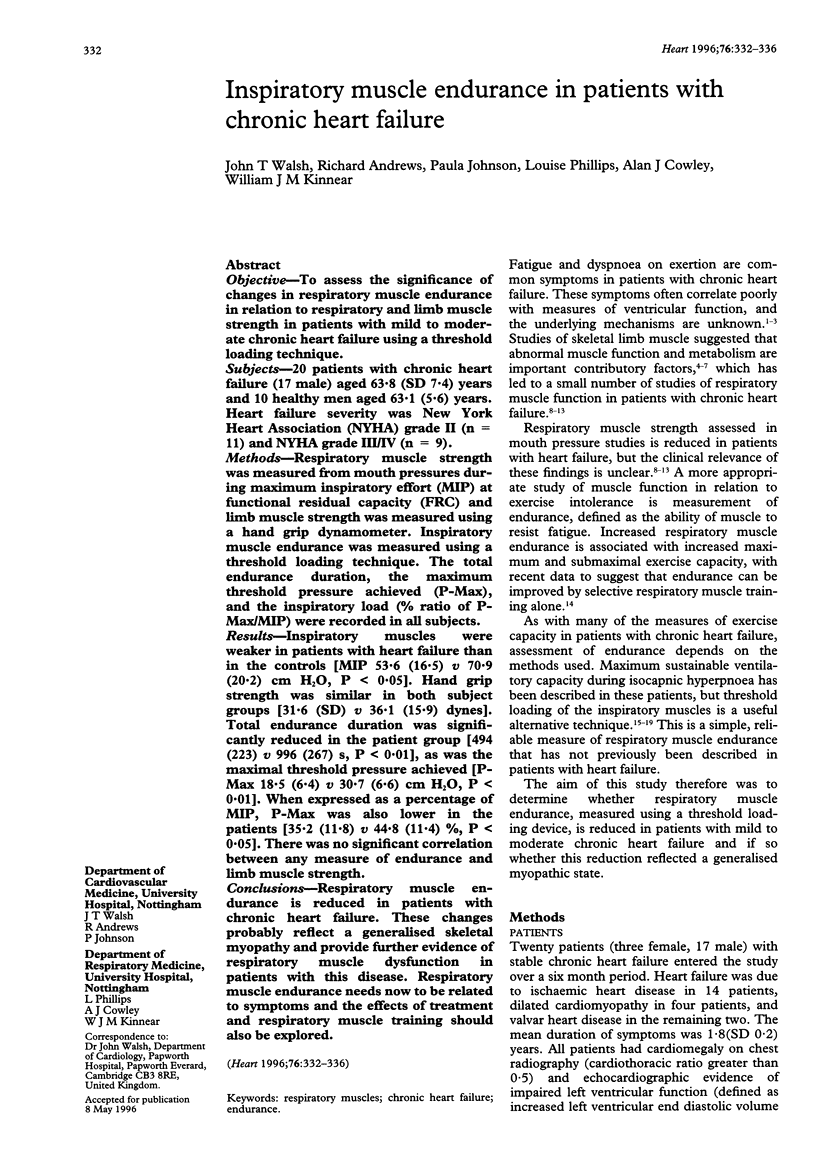
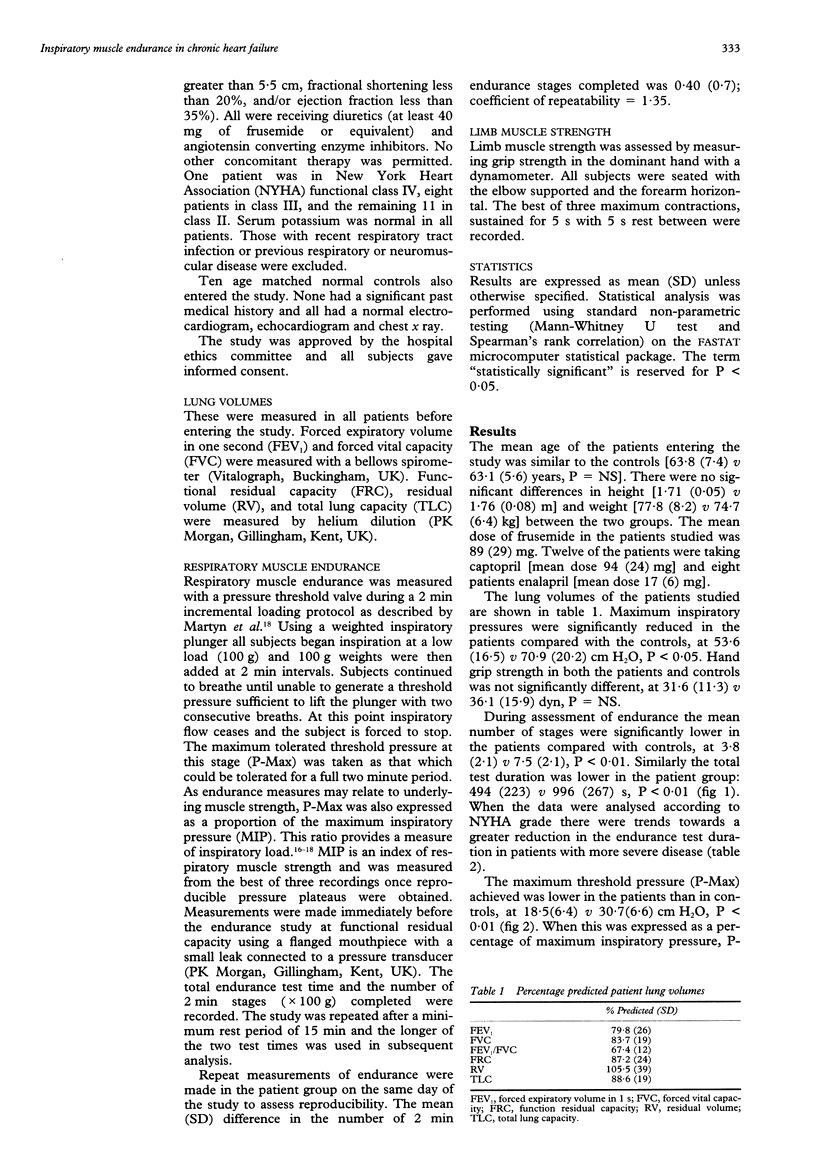
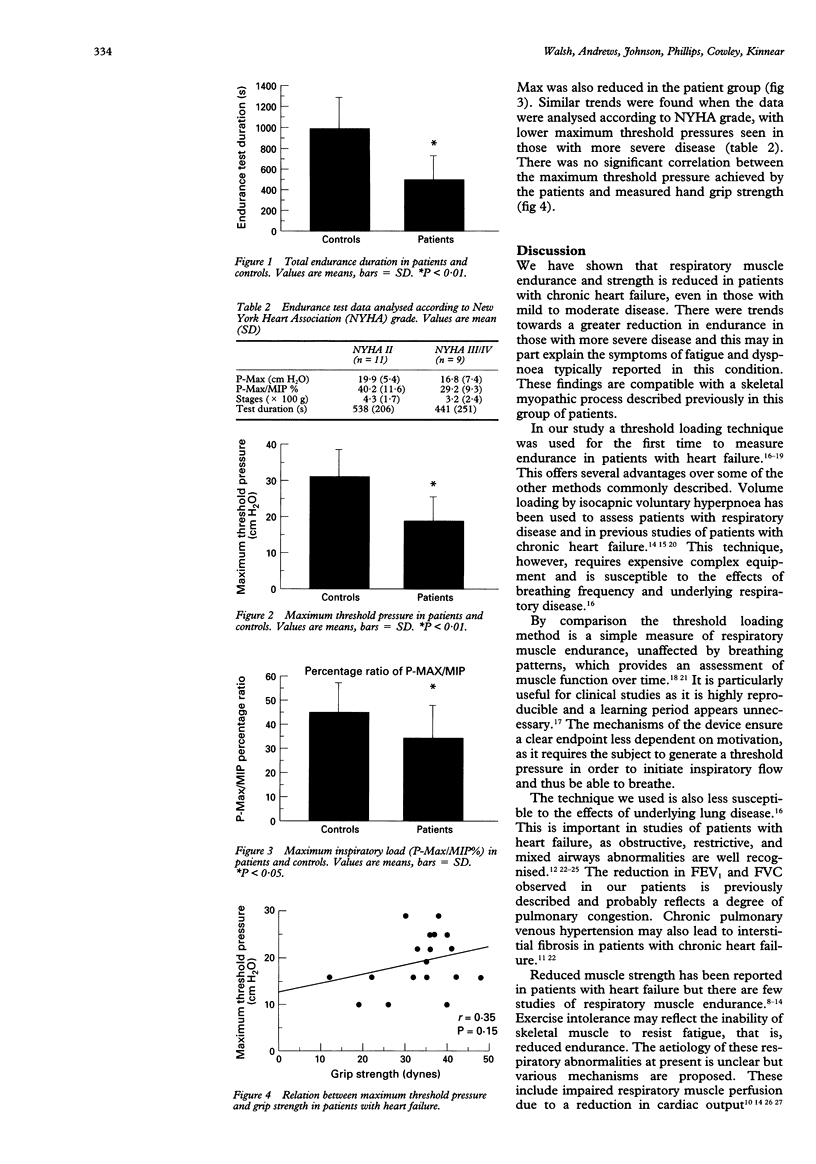
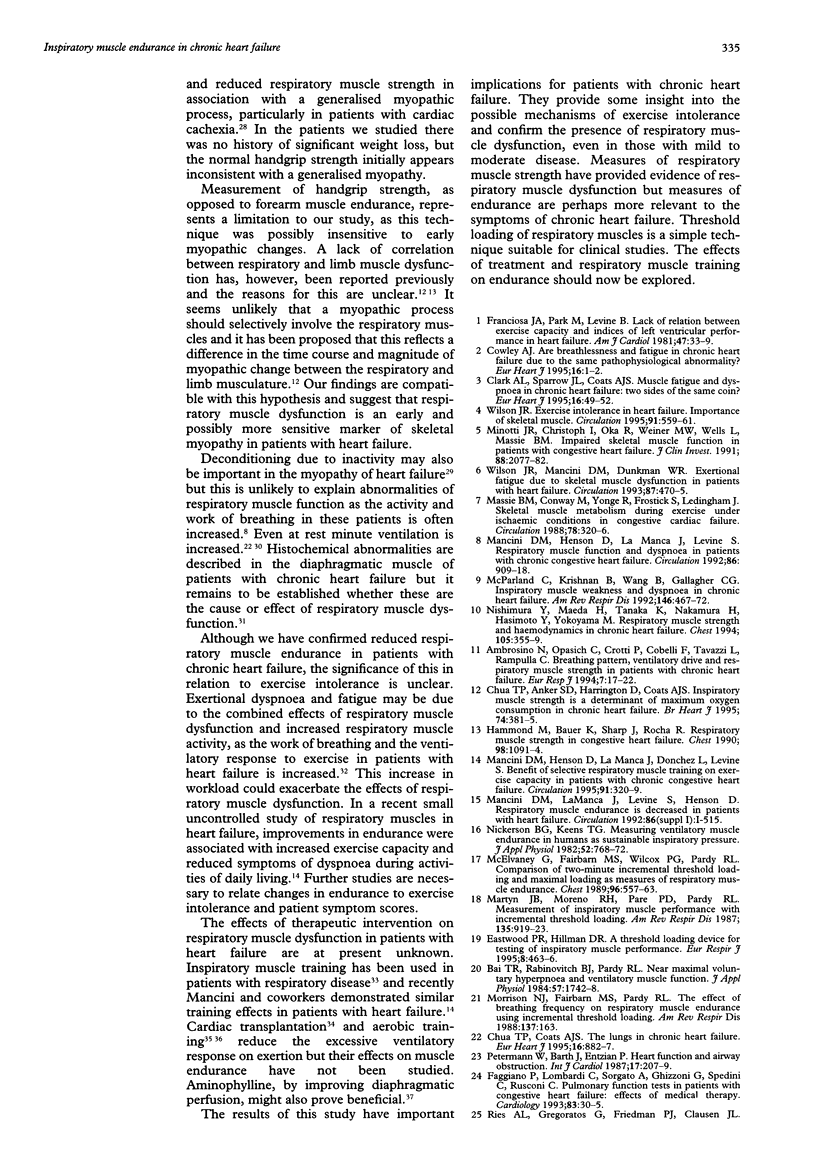
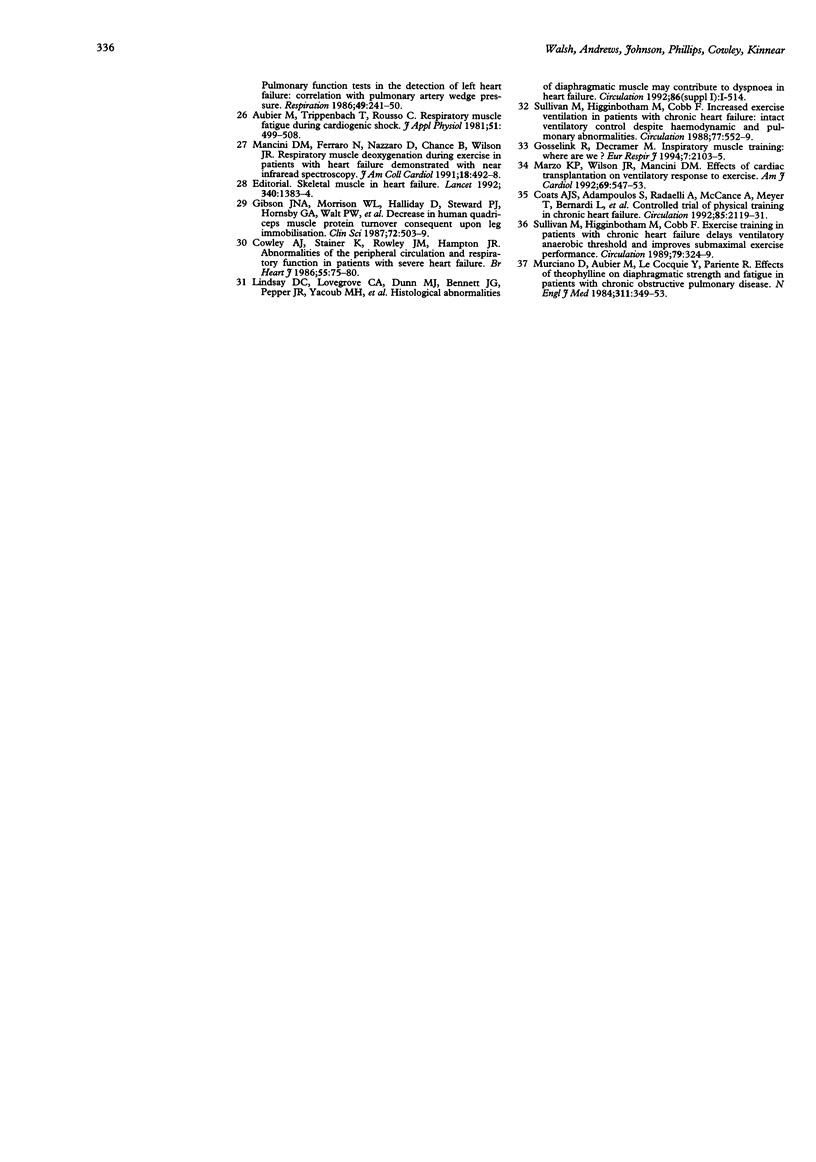
Selected References
These references are in PubMed. This may not be the complete list of references from this article.
- Ambrosino N., Opasich C., Crotti P., Cobelli F., Tavazzi L., Rampulla C. Breathing pattern, ventilatory drive and respiratory muscle strength in patients with chronic heart failure. Eur Respir J. 1994 Jan;7(1):17–22. doi: 10.1183/09031936.94.07010017. [DOI] [PubMed] [Google Scholar]
- Aubier M., Trippenbach T., Roussos C. Respiratory muscle fatigue during cardiogenic shock. J Appl Physiol Respir Environ Exerc Physiol. 1981 Aug;51(2):499–508. doi: 10.1152/jappl.1981.51.2.499. [DOI] [PubMed] [Google Scholar]
- Bai T. R., Rabinovitch B. J., Pardy R. L. Near-maximal voluntary hyperpnea and ventilatory muscle function. J Appl Physiol Respir Environ Exerc Physiol. 1984 Dec;57(6):1742–1748. doi: 10.1152/jappl.1984.57.6.1742. [DOI] [PubMed] [Google Scholar]
- Chua T. P., Anker S. D., Harrington D., Coats A. J. Inspiratory muscle strength is a determinant of maximum oxygen consumption in chronic heart failure. Br Heart J. 1995 Oct;74(4):381–385. doi: 10.1136/hrt.74.4.381. [DOI] [PMC free article] [PubMed] [Google Scholar]
- Chua T. P., Coats A. J. The lungs in chronic heart failure. Eur Heart J. 1995 Jul;16(7):882–887. doi: 10.1093/oxfordjournals.eurheartj.a061019. [DOI] [PubMed] [Google Scholar]
- Clark A. L., Sparrow J. L., Coats A. J. Muscle fatigue and dyspnoea in chronic heart failure: two sides of the same coin? Eur Heart J. 1995 Jan;16(1):49–52. doi: 10.1093/eurheartj/16.1.49. [DOI] [PubMed] [Google Scholar]
- Coats A. J., Adamopoulos S., Radaelli A., McCance A., Meyer T. E., Bernardi L., Solda P. L., Davey P., Ormerod O., Forfar C. Controlled trial of physical training in chronic heart failure. Exercise performance, hemodynamics, ventilation, and autonomic function. Circulation. 1992 Jun;85(6):2119–2131. doi: 10.1161/01.cir.85.6.2119. [DOI] [PubMed] [Google Scholar]
- Cowley A. J. Are breathlessness and fatigue in chronic heart failure due to the same pathophysiological abnormality? Eur Heart J. 1995 Jan;16(1):1–2. doi: 10.1093/eurheartj/16.1.1. [DOI] [PubMed] [Google Scholar]
- Cowley A. J., Stainer K., Rowley J. M., Hampton J. R. Abnormalities of the peripheral circulation and respiratory function in patients with severe heart failure. Br Heart J. 1986 Jan;55(1):75–80. doi: 10.1136/hrt.55.1.75. [DOI] [PMC free article] [PubMed] [Google Scholar]
- Eastwood P. R., Hillman D. R. A threshold loading device for testing of inspiratory muscle performance. Eur Respir J. 1995 Mar;8(3):463–466. doi: 10.1183/09031936.95.08030463. [DOI] [PubMed] [Google Scholar]
- Faggiano P., Lombardi C., Sorgato A., Ghizzoni G., Spedini C., Rusconi C. Pulmonary function tests in patients with congestive heart failure: effects of medical therapy. Cardiology. 1993;83(1-2):30–35. doi: 10.1159/000175944. [DOI] [PubMed] [Google Scholar]
- Franciosa J. A., Park M., Levine T. B. Lack of correlation between exercise capacity and indexes of resting left ventricular performance in heart failure. Am J Cardiol. 1981 Jan;47(1):33–39. doi: 10.1016/0002-9149(81)90286-1. [DOI] [PubMed] [Google Scholar]
- Gibson J. N., Halliday D., Morrison W. L., Stoward P. J., Hornsby G. A., Watt P. W., Murdoch G., Rennie M. J. Decrease in human quadriceps muscle protein turnover consequent upon leg immobilization. Clin Sci (Lond) 1987 Apr;72(4):503–509. doi: 10.1042/cs0720503. [DOI] [PubMed] [Google Scholar]
- Gosselink R., Decramer M. Inspiratory muscle training: where are we? Eur Respir J. 1994 Dec;7(12):2103–2105. doi: 10.1183/09031936.94.07122103. [DOI] [PubMed] [Google Scholar]
- Hammond M. D., Bauer K. A., Sharp J. T., Rocha R. D. Respiratory muscle strength in congestive heart failure. Chest. 1990 Nov;98(5):1091–1094. doi: 10.1378/chest.98.5.1091. [DOI] [PubMed] [Google Scholar]
- Mancini D. M., Ferraro N., Nazzaro D., Chance B., Wilson J. R. Respiratory muscle deoxygenation during exercise in patients with heart failure demonstrated with near-infrared spectroscopy. J Am Coll Cardiol. 1991 Aug;18(2):492–498. doi: 10.1016/0735-1097(91)90605-9. [DOI] [PubMed] [Google Scholar]
- Mancini D. M., Henson D., La Manca J., Donchez L., Levine S. Benefit of selective respiratory muscle training on exercise capacity in patients with chronic congestive heart failure. Circulation. 1995 Jan 15;91(2):320–329. doi: 10.1161/01.cir.91.2.320. [DOI] [PubMed] [Google Scholar]
- Mancini D. M., Henson D., LaManca J., Levine S. Respiratory muscle function and dyspnea in patients with chronic congestive heart failure. Circulation. 1992 Sep;86(3):909–918. doi: 10.1161/01.cir.86.3.909. [DOI] [PubMed] [Google Scholar]
- Martyn J. B., Moreno R. H., Paré P. D., Pardy R. L. Measurement of inspiratory muscle performance with incremental threshold loading. Am Rev Respir Dis. 1987 Apr;135(4):919–923. doi: 10.1164/arrd.1987.135.4.919. [DOI] [PubMed] [Google Scholar]
- Marzo K. P., Wilson J. R., Mancini D. M. Effects of cardiac transplantation on ventilatory response to exercise. Am J Cardiol. 1992 Feb 15;69(5):547–553. doi: 10.1016/0002-9149(92)91002-l. [DOI] [PubMed] [Google Scholar]
- Massie B. M., Conway M., Rajagopalan B., Yonge R., Frostick S., Ledingham J., Sleight P., Radda G. Skeletal muscle metabolism during exercise under ischemic conditions in congestive heart failure. Evidence for abnormalities unrelated to blood flow. Circulation. 1988 Aug;78(2):320–326. doi: 10.1161/01.cir.78.2.320. [DOI] [PubMed] [Google Scholar]
- McElvaney G., Fairbarn M. S., Wilcox P. G., Pardy R. L. Comparison of two-minute incremental threshold loading and maximal loading as measures of respiratory muscle endurance. Chest. 1989 Sep;96(3):557–563. doi: 10.1378/chest.96.3.557. [DOI] [PubMed] [Google Scholar]
- McParland C., Krishnan B., Wang Y., Gallagher C. G. Inspiratory muscle weakness and dyspnea in chronic heart failure. Am Rev Respir Dis. 1992 Aug;146(2):467–472. doi: 10.1164/ajrccm/146.2.467. [DOI] [PubMed] [Google Scholar]
- Murciano D., Aubier M., Lecocguic Y., Pariente R. Effects of theophylline on diaphragmatic strength and fatigue in patients with chronic obstructive pulmonary disease. N Engl J Med. 1984 Aug 9;311(6):349–353. doi: 10.1056/NEJM198408093110601. [DOI] [PubMed] [Google Scholar]
- Nickerson B. G., Keens T. G. Measuring ventilatory muscle endurance in humans as sustainable inspiratory pressure. J Appl Physiol Respir Environ Exerc Physiol. 1982 Mar;52(3):768–772. doi: 10.1152/jappl.1982.52.3.768. [DOI] [PubMed] [Google Scholar]
- Nishimura Y., Maeda H., Tanaka K., Nakamura H., Hashimoto Y., Yokoyama M. Respiratory muscle strength and hemodynamics in chronic heart failure. Chest. 1994 Feb;105(2):355–359. doi: 10.1378/chest.105.2.355. [DOI] [PubMed] [Google Scholar]
- Petermann W., Barth J., Entzian P. Heart failure and airway obstruction. Int J Cardiol. 1987 Nov;17(2):207–209. doi: 10.1016/0167-5273(87)90132-x. [DOI] [PubMed] [Google Scholar]
- Ries A. L., Gregoratos G., Friedman P. J., Clausen J. L. Pulmonary function tests in the detection of left heart failure: correlation with pulmonary artery wedge pressure. Respiration. 1986;49(4):241–250. doi: 10.1159/000194886. [DOI] [PubMed] [Google Scholar]
- Schuler G., Hambrecht R., Schlierf G., Niebauer J., Hauer K., Neumann J., Hoberg E., Drinkmann A., Bacher F., Grunze M. Regular physical exercise and low-fat diet. Effects on progression of coronary artery disease. Circulation. 1992 Jul;86(1):1–11. doi: 10.1161/01.cir.86.1.1. [DOI] [PubMed] [Google Scholar]
- Schuler G., Hambrecht R., Schlierf G., Niebauer J., Hauer K., Neumann J., Hoberg E., Drinkmann A., Bacher F., Grunze M. Regular physical exercise and low-fat diet. Effects on progression of coronary artery disease. Circulation. 1992 Jul;86(1):1–11. doi: 10.1161/01.cir.86.1.1. [DOI] [PubMed] [Google Scholar]
- Sullivan M. J., Higginbotham M. B., Cobb F. R. Exercise training in patients with chronic heart failure delays ventilatory anaerobic threshold and improves submaximal exercise performance. Circulation. 1989 Feb;79(2):324–329. doi: 10.1161/01.cir.79.2.324. [DOI] [PubMed] [Google Scholar]
- Sullivan M. J., Higginbotham M. B., Cobb F. R. Increased exercise ventilation in patients with chronic heart failure: intact ventilatory control despite hemodynamic and pulmonary abnormalities. Circulation. 1988 Mar;77(3):552–559. doi: 10.1161/01.cir.77.3.552. [DOI] [PubMed] [Google Scholar]
- Wilson J. R. Exercise intolerance in heart failure. Importance of skeletal muscle. Circulation. 1995 Jan 15;91(2):559–561. doi: 10.1161/01.cir.91.2.559. [DOI] [PubMed] [Google Scholar]
- Wilson J. R., Mancini D. M., Dunkman W. B. Exertional fatigue due to skeletal muscle dysfunction in patients with heart failure. Circulation. 1993 Feb;87(2):470–475. doi: 10.1161/01.cir.87.2.470. [DOI] [PubMed] [Google Scholar]


